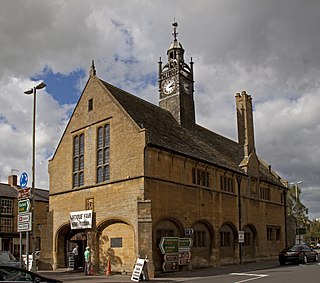
Moreton-in-Marsh is a market town in the Evenlode Valley, within the Cotswolds district and Area of Outstanding Natural Beauty in Gloucestershire, England.
Victor Benjamin Neuburg was an English poet and writer. An intimate associate of Aleister Crowley, he wrote on the subject of occultism, including Theosophy and Thelema. He edited "The Poet's Corner" column in the Sunday Referee, and also published the early works of Dylan Thomas and Pamela Hansford Johnson.

Philip William of Neuburg, Elector Palatine was Count Palatine of Neuburg from 1653 to 1690, Duke of Jülich and Berg from 1653 to 1679 and Elector of the Palatinate from 1685 to 1690. He was the son of Wolfgang Wilhelm, Count Palatine of Neuburg and Magdalene of Bavaria.

The Equinox is a periodical that serves as the official organ of the A∴A∴, a magical order founded by Aleister Crowley. Begun in 1909, it mainly features articles about occultism and magick, while several issues also contained poetry, fiction, plays, artwork, and biographies. The most recent issue was published in 1998.

Amy X Neuburg is an American composer, vocalist, and electronic musician.

Palatinate-Neuburg was a territory of the Holy Roman Empire, founded in 1505 by a branch of the House of Wittelsbach. Its capital was Neuburg an der Donau. Its area was about 2,750 km2, with a population of some 100,000.

Magdalene of Bavaria was a German princess of the House of Wittelsbach who became Countess Palatine of Neuburg and Duchess of Jülich-Berg by marriage.
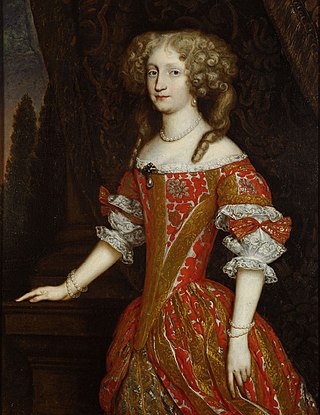
Eleonore Magdalene Therese of Neuburg was Holy Roman Empress, German Queen, Archduchess of Austria, Queen of Hungary and Bohemia as the third and final wife of Leopold I, Holy Roman Emperor. Before her marriage and during her widowhood, she led an ascetic and monastic life, translating the Bible from Latin to German and defended the Order of the Discalced Carmelites. Reputed to be one of the most educated and virtuous women of her time, Eleonore took part in the political affairs during the reign of her husband and sons, especially regarding court revenue and foreign relationships. She served as regent for a few months in 1711, period in which she signed the Treaty of Szatmár, which recognized the rights of her descendants to the Hungarian throne.
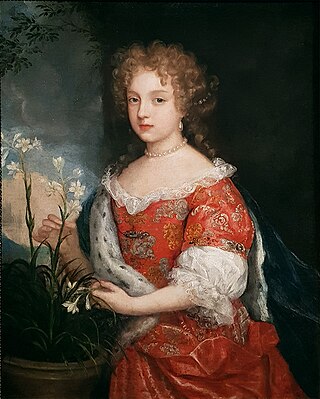
Princess Ludwika Karolina Radziwiłł was a magnate Princess of the Grand Duchy of Lithuania in the Polish–Lithuanian Commonwealth and an active reformer.

The War of the Succession of Landshut resulted from a dispute between the duchies of Bavaria-Munich and Bavaria-Landshut (Bayern-Landshut). An earlier agreement between the different Wittelsbach lines, the Treaty of Pavia (1329), concerned the law of succession and stated that if one branch should become extinct in the male line then the other would inherit. This agreement disregarded imperial law, which stipulated that the Holy Roman emperor should inherit should a line fail.

Neuburg am Inn is a municipality in the district of Passau in Bavaria in Germany.

Philipp Ludwig of Neuburg was Count Palatine of Neuburg from 1569 until 1614.
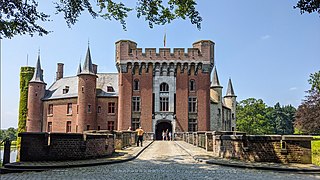
Wijnendale Castle is a historic residence in Wijnendale, West Flanders in Belgium which was once a medieval castle. The present buildings largely date to a nineteenth century restoration, though parts of the north wing still date to the fifteenth century. One wing is currently inhabited by the present owners of the castle, while another is open to the public as a museum.

Ruprecht, Count Palatine of the Rhine, was the third son of Philip, Elector Palatine of the House of Wittelsbach and he was Bishop of Freising from 1495 to 1498.

Neuburg Castle is a ruined castle in Untervaz in the Canton of Graubünden in Switzerland. It is a Swiss heritage site of national significance.
Victor Edward Neuburg was a scholar.

The Great Last Judgement is an oil on canvas altarpiece, painted by the Flemish artist Peter Paul Rubens between 1614 and 1617. He created the composition and final touches and his is the only signature on the work, though it is believed between nine and nineteen studio assistants also worked on it. Its name distinguishes it from the same artist's The Small Last Judgement of 1619 and his The Fall of the Damned of 1620.
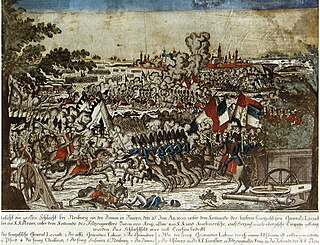
The Battle of Neuburg occurred on 27 June 1800 in the south German state of Bavaria, on the southern bank of the Danube river. Neuburg is located on the Danube between Ingolstadt and Donauwörth. This battle occurred late in the War of the Second Coalition (1798–1802), the second war between Revolutionary France and the conservative European monarchies, which included at one time or another Britain, Habsburg Austria, Russia, the Ottoman Empire (Turkey), Portugal and Naples. After a series of reverses, several of the allies withdrew from the Coalition. By 1800, Napoleon's military victories in northern Italy challenged Habsburg supremacy there. French victories in the upper Danubian territories opened a route along that river to Vienna.

Leopoldine Eleonore of Neuburg was a German princess who was a Countess Palatine of Neuburg and member of the Neuburg branch House of Wittelsbach by birth. She was also a Princess of the Palatinate while her father ruled as Elector Palatine.
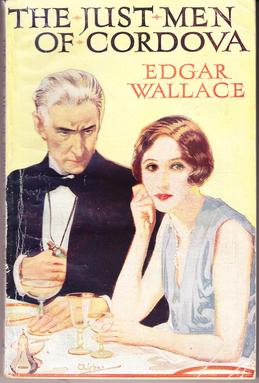
The Just Men of Cordova is a 1917 thriller novel by the British writer Edgar Wallace.


















